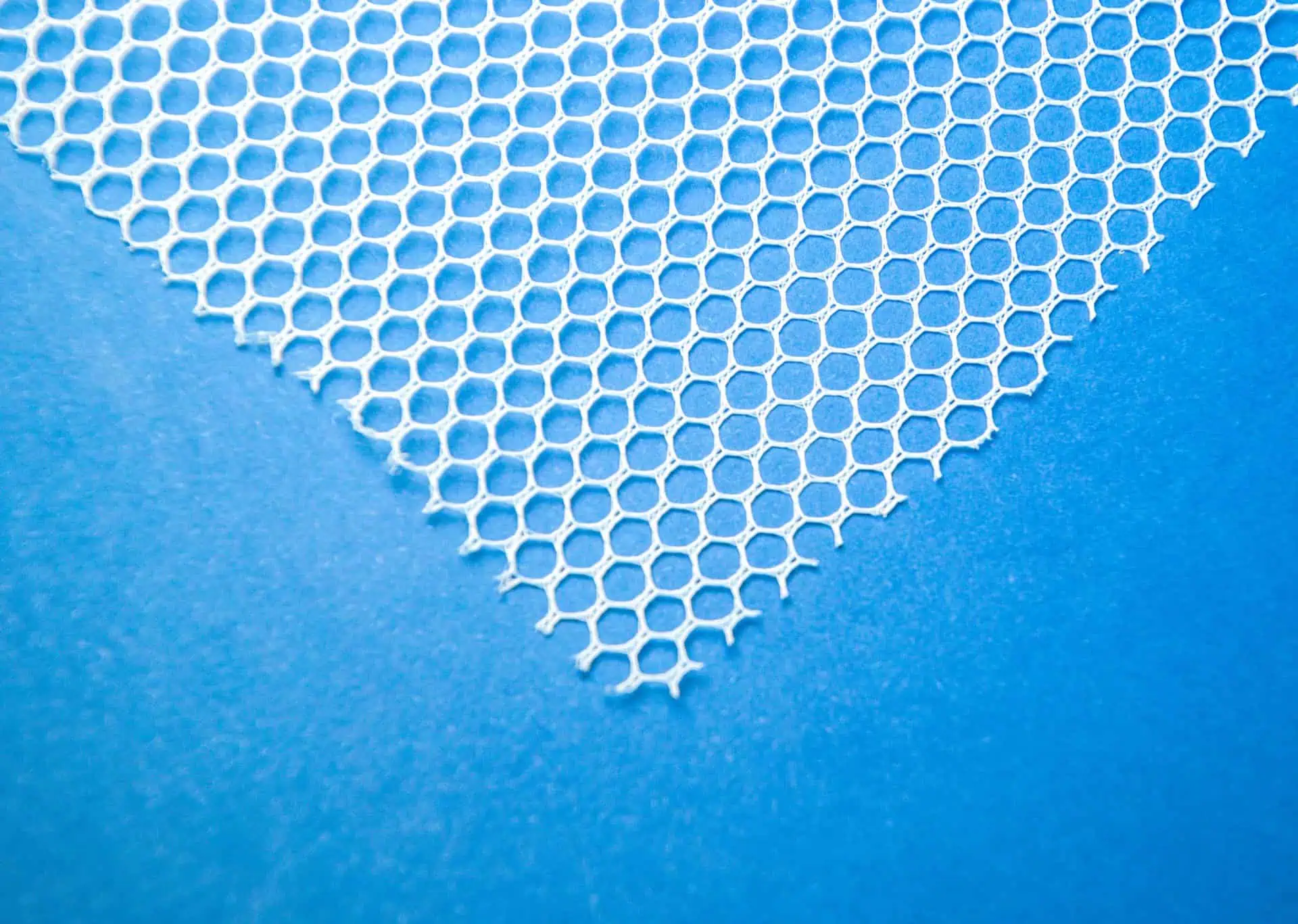What Are The Psychological Effects Of Transvaginal Mesh Surgery Complications?
- Last Updated: July 14th, 2025

Attorney Jessica Paluch-Hoerman, founder of TruLaw, has over 28 years of experience as a personal injury and mass tort attorney, and previously worked as an international tax attorney at Deloitte. Jessie collaborates with attorneys nationwide — enabling her to share reliable, up-to-date legal information with our readers.
Legally Reviewed
This article has been written and reviewed for legal accuracy and clarity by the team of writers and legal experts at TruLaw and is as accurate as possible. This content should not be taken as legal advice from an attorney. If you would like to learn more about our owner and experienced injury lawyer, Jessie Paluch, you can do so here.
Fact-Checked
TruLaw does everything possible to make sure the information in this article is up to date and accurate. If you need specific legal advice about your case, contact us by using the chat on the bottom of this page. This article should not be taken as advice from an attorney.
Key takeaways:
- The profound impact of transvaginal mesh surgery complications on mental well-being highlights the strong link between chronic pain and emotional distress, exacerbating patients' struggles.
- Persistent pain following pelvic floor disorder treatments can trigger anxiety and depression, particularly in conditions like stress urinary incontinence or pelvic organ prolapse, which affect intimate functions and may lead to feelings of isolation and embarrassment.
- The psychological turmoil surrounding transvaginal mesh implants, including uncertainty and multiple surgeries, erodes trust in one's body and adds layers of stress, emphasizing the intricate interplay between physical health problems related to mesh complications and mental stability.
Overview of Transvaginal Mesh Surgery Complications
On this page, we will discuss an overview of transvaginal mesh surgery, psychological effects of transvaginal mesh surgery complications, how to file a transvaginal mesh surgery lawsuit, and much more.
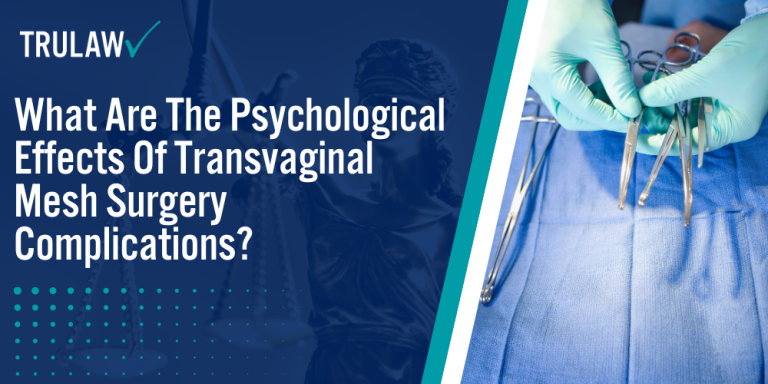
Intro to Transvaginal Mesh Surgery
Transvaginal mesh surgery involves implanting a surgical mesh device transvaginally to reinforce weakened or damaged pelvic tissue.
The key aspects of transvaginal mesh surgery to consider include:
- The suitability of surgical intervention through the transvaginal approach must be evaluated on a case-to-case basis.
- While surgical mesh is designed to provide lasting solutions, there is a risk of complications that patients should be aware of.
- The surgical technique and the type of mesh used might vary depending on the specific condition and the individual’s health.
- A thorough preoperative assessment and identification of potential risks are imperative for a safe and effective treatment outcome.
If you or a loved one has experienced complications related to transvaginal mesh surgery, you may be able to seek compensation.
Contact TruLaw using the chat on this page to learn if you qualify to file a transvaginal mesh lawsuit today.
Table of Contents
Conditions Treated with Transvaginal Mesh Surgery
Transvaginal mesh surgery is employed primarily for two distinct medical conditions: Pelvic Organ Prolapse (POP) and Stress Urinary Incontinence (SUI).
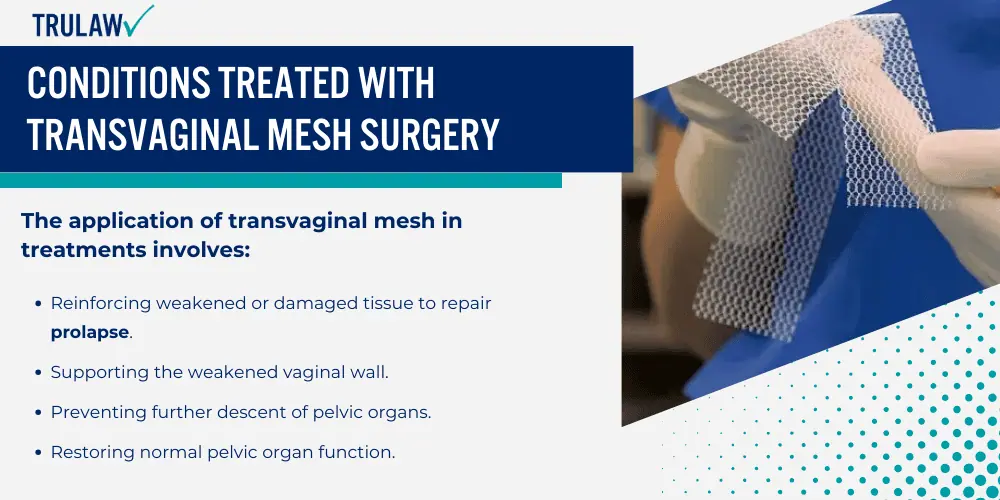
These conditions affect the pelvic region and can significantly impact the quality of life.
Pelvic Organ Prolapse
Pelvic Organ Prolapse takes place when pelvic organs like the bladder, rectum, or uterus descend into the vaginal area owing to weakened supporting muscles and tissues.
This condition can lead to discomfort and a variety of symptoms.
The application of transvaginal mesh in treatments involves:
- Reinforcing weakened or damaged tissue to repair prolapse.
- Supporting the weakened vaginal wall.
- Preventing further descent of pelvic organs.
- Restoring normal pelvic organ function.
Stress Urinary Incontinence
On the other hand, Stress Urinary Incontinence is characterized by the involuntary leakage of urine during physical activities that put pressure on the bladder, such as coughing or exercising.
Transvaginal mesh can provide support to the urethra or bladder neck, which aids in urinary control.
Procedures to rectify stress incontinence may include:
- Placement of a sling to support the urethra.
- Stabilization of the bladder neck.
- Reduction of urinary leakage.
- Improvement of overall urinary function.
Transvaginal Mesh Surgery Procedures
Transvaginal mesh surgery is a critical intervention for certain pelvic floor disorders.
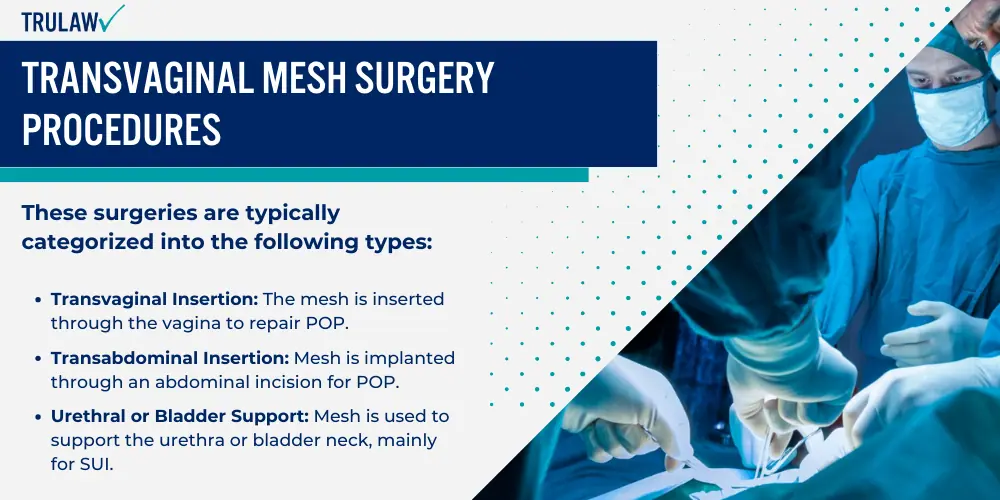
The following sections provide a focused look at the surgical methods employed and specific considerations for transvaginal prolapse repair.
The Surgical Procedures of Transvaginal Mesh Operations
Transvaginal mesh surgery involves the placement of a net-like implant to reinforce weakened pelvic tissues.
The three main surgical procedures performed using transvaginal mesh aim to address conditions like pelvic organ prolapse (POP) and sometimes stress urinary incontinence (SUI).
These surgeries are typically categorized into the following types:
- Transvaginal Insertion: The mesh is inserted through the vagina to repair POP.
- Transabdominal Insertion: Mesh is implanted through an abdominal incision for POP.
- Urethral or Bladder Support: Mesh is used to support the urethra or bladder neck, mainly for SUI.
In a logical progression from less to more invasive, each method is chosen based on the individual’s needs and the severity of prolapse.
Transvaginal Prolapse Repair
The transvaginal repair of pelvic organs is a specific subset of mesh surgery targeting the correction of prolapsed pelvic organs through the vaginal canal.
Surgical steps generally include:
- Evaluation of the pelvic floor and selection of appropriate mesh material.
- Making a vaginal incision to provide access to the pelvic organs.
- Placement of the surgical mesh beneath the vaginal lining to provide the necessary support.
- Secure attachment of the mesh to surrounding tissues to ensure correct anatomical alignment.
During transvaginal prolapse repair, surgeons may encounter various challenges that dictate their approach, such as the degree of tissue weakness and the presence of comorbidities.
The chosen mesh must provide both the stability and biocompatibility required for a successful outcome.
Benefits and Risks of Transvaginal Mesh Surgery
Transvaginal mesh surgery, an intervention for pelvic organ prolapse, involves specific advantages and inherent risks that are crucial for patient consideration.
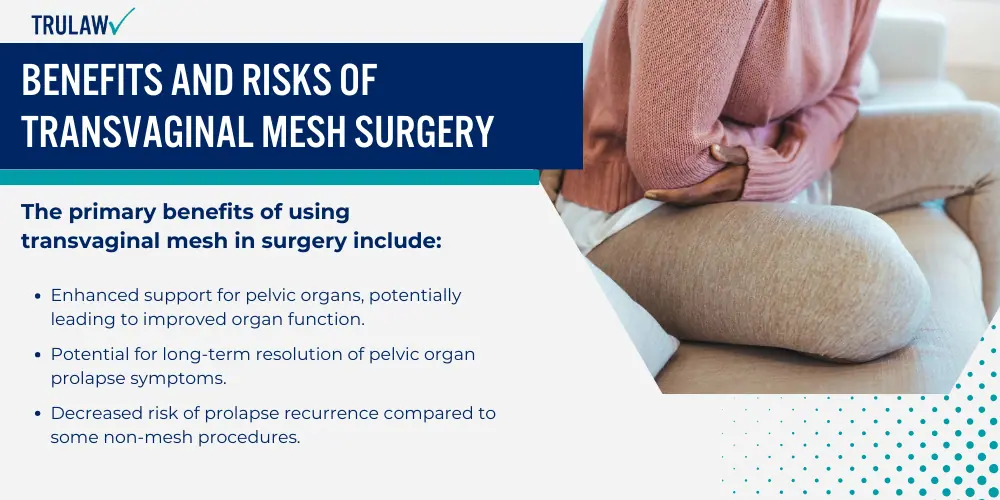
Advantages of Using Transvaginal Mesh
Transvaginal mesh offers enhanced support for pelvic organs, potentially leading to improved organ function and a potential long-term resolution of pelvic organ prolapse symptoms.
Compared to some non-mesh procedures, it also presents a decreased risk of prolapse recurrence and may provide quick relief from symptoms, improving quality of life.
The primary benefits of using transvaginal mesh in surgery include:
- Enhanced support for pelvic organs, potentially leading to improved organ function.
- Potential for long-term resolution of pelvic organ prolapse symptoms.
- Decreased risk of prolapse recurrence compared to some non-mesh procedures.
- It may provide quick relief from symptoms, improving quality of life.
Potential Complications and Risks
On the other hand, the use of transvaginal mesh can be accompanied by several risks and mesh complications.
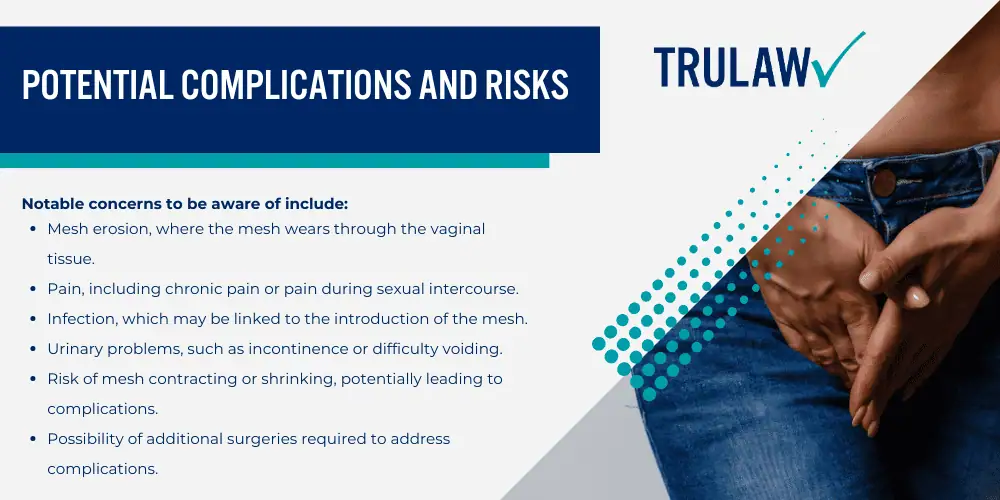
Notable concerns to be aware of include:
- Mesh erosion, where the mesh wears through the vaginal tissue.
- Pain, including chronic pain or pain during sexual intercourse.
- Infection, which may be linked to the introduction of the mesh.
- Urinary problems, such as incontinence or difficulty voiding.
- Risk of mesh contracting or shrinking, potentially leading to complications.
- Possibility of additional surgeries required to address complications.
Postoperative Care: Transvaginal Mesh Surgery
Following transvaginal mesh surgery, postoperative care is paramount for a successful recovery and rehabilitation.
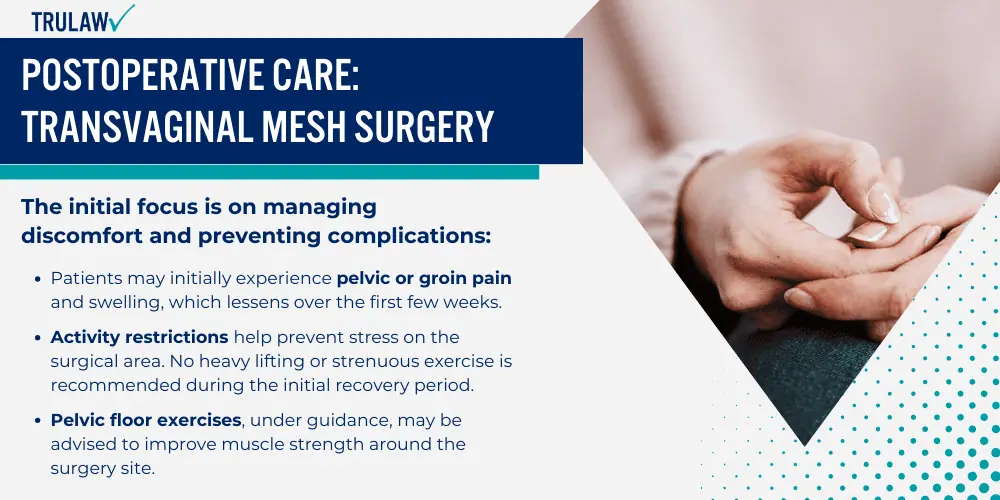
The patient needs to adhere to the prescribed follow-up schedules and understand the progressive stages of healing.
Recovery and Rehabilitation
Recovery after transvaginal mesh surgery involves several steps to ensure proper healing and function.
The initial focus is on managing discomfort and preventing complications:
- Patients may initially experience pelvic or groin pain and swelling, which lessens over the first few weeks.
- Activity restrictions help prevent stress on the surgical area. No heavy lifting or strenuous exercise is recommended during the initial recovery period.
- Pelvic floor exercises, under guidance, may be advised to improve muscle strength around the surgery site.
- Attention to personal hygiene is crucial to avoid infection.
- Dietary modifications can help manage bowel movements, reducing strain on the area.
Routine Check-Ups and Monitoring
Regular follow-up appointments are crucial for assessing the outcomes of mesh surgery and detecting potential issues early.
These appointments typically begin with a postoperative visit within several weeks after surgery to evaluate initial healing, followed by subsequent check-ups to monitor mesh integration and overall recovery progress.
Scheduled follow-ups are vital for monitoring the outcomes of the mesh surgery and identifying any potential issues early on:
- The first postoperative visit often occurs within several weeks after surgery to assess initial healing.
- Subsequent check-ups typically review progress and ensure that the mesh has integrated correctly without complications.
- Ongoing assessments might include pelvic exams or imaging tests if necessary.
- It is important to report any unusual symptoms, such as increased pain, bleeding, or signs of infection, to a healthcare provider immediately.
Alternatives to Transvaginal Mesh Surgery
For those seeking solutions for pelvic organ prolapse or related conditions, alternatives to transvaginal mesh surgery come in various forms.
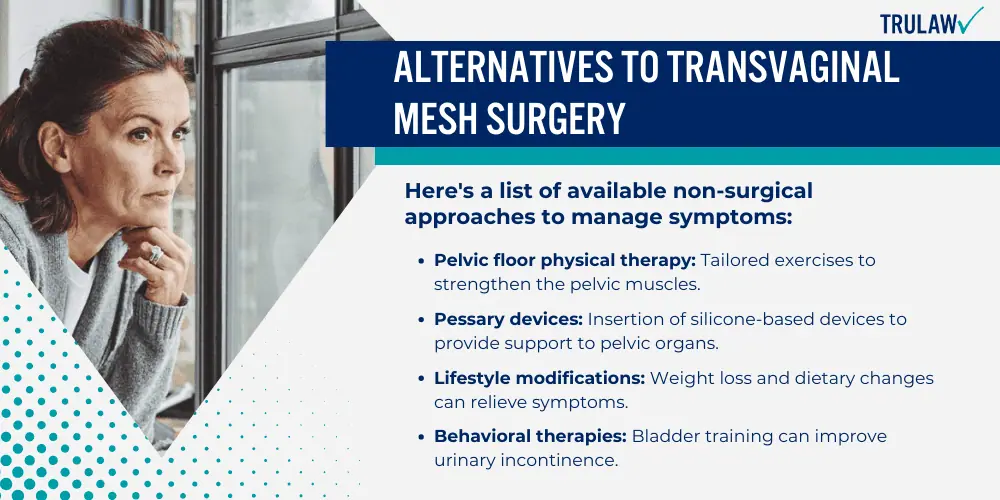
This section explores non-surgical treatment options as well as surgical alternatives without mesh.
Non-Surgical Treatment Options
Patients may consider non-surgical treatments as a first line of defense or when mesh surgery isn’t suitable.
Here’s a list of available non-surgical approaches to manage symptoms:
- Pelvic floor physical therapy: Tailored exercises to strengthen the pelvic muscles.
- Pessary devices: Insertion of silicone-based devices to provide support to pelvic organs.
- Lifestyle modifications: Weight loss and dietary changes can relieve symptoms.
- Behavioral therapies: Bladder training can improve urinary incontinence.
- Hormonal treatments: Topical estrogen may be used to rejuvenate vaginal tissues.
- Electrical stimulation: To stimulate and strengthen pelvic floor muscles.
Surgical Alternatives Without Mesh
Several options are available for patients who seek surgical interventions without mesh, including native tissue repair, uterosacral ligament suspension, sacral colpopexy using autologous materials, colpocleisis, obturator fascia suspension, and laparoscopic sacrohysteropexy.
These procedures utilize the patient’s own tissues or alternative materials for pelvic support and reconstruction, offering viable alternatives for those who prefer to avoid mesh implants.
For patients who require surgery but prefer to avoid mesh, the following surgical alternatives are available:
- Native tissue repair: Utilizes the patient’s own tissues to provide support.
- Uterosacral ligament suspension: Fixation of the vaginal apex to the uterosacral ligaments.
- Sacral colpopexy using autologous materials: Using the patient’s tissue for pelvic reconstruction.
- Colpocleisis: Closure of the vaginal canal, typically for women who are no longer sexually active.
- Obturator fascia suspension: An option for mid-urethral sling procedure without mesh.
- Laparoscopic sacrohysteropexy: Uterus preservation by attaching it to the sacrum via the laparoscope.
Regulatory Status and Guidelines: Transvaginal Mesh Surgery
The regulatory landscape for transvaginal mesh surgery has evolved significantly with the FDA’s active involvement in assessing the safety and efficacy of mesh products used in such procedures.
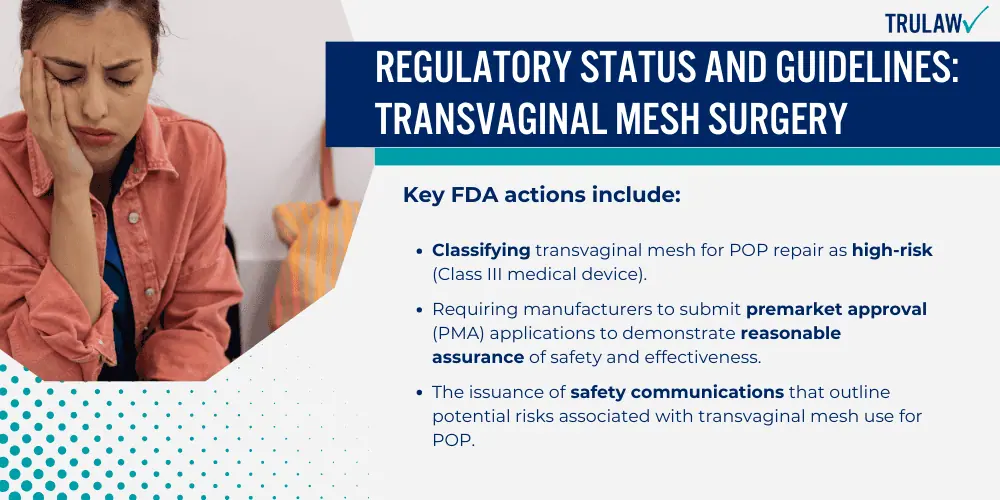
FDA Determinations and Rulings
The FDA has played a pivotal role in regulating mesh devices used for transvaginal pelvic organ prolapse (POP) surgeries.
Through its authority, the agency has made several key determinations and rulings that reflect the evolving stance on the safety and utility of transvaginal mesh.
Key FDA actions include:
- Classifying transvaginal mesh for POP repair as high-risk (Class III medical device).
- Requiring manufacturers to submit premarket approval (PMA) applications to demonstrate reasonable assurance of safety and effectiveness.
- The issuance of safety communications that outline potential risks associated with transvaginal mesh use for POP.
- In 2019, the FDA ordered all remaining manufacturers to stop selling and distributing surgical mesh for transvaginal repair of POP in the U.S. after failing to provide reasonable assurance of safety and effectiveness.
Following these determinations, the FDA continues to monitor postmarket surveillance studies to evaluate the long-term outcomes of transvaginal mesh surgeries.
Transvaginal Mesh Surgery: Patient Stories and Experiences
Women undergo transvaginal mesh surgery for various conditions, such as stress urinary incontinence (SUI) and pelvic organ prolapse (POP).
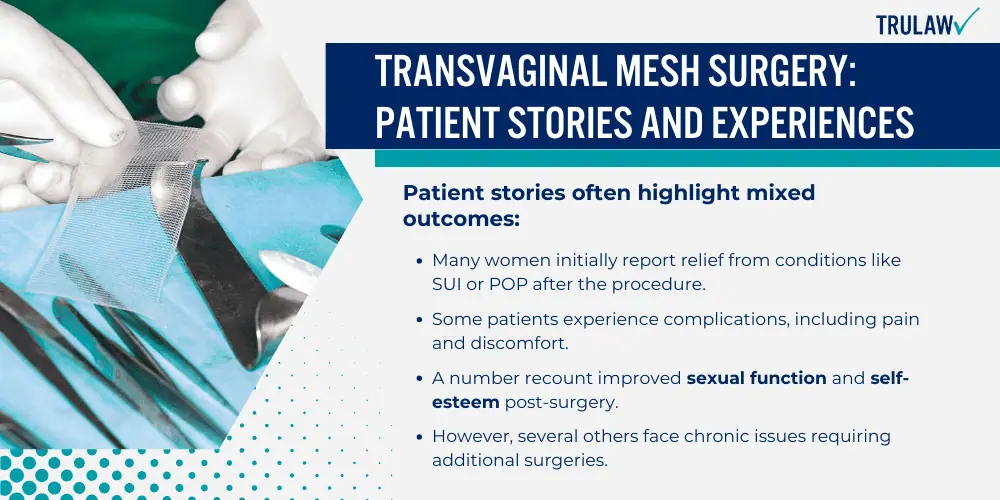
Personal accounts from patients provide valuable insights into the real-world impacts of this medical intervention on quality of life.
Patient stories often highlight mixed outcomes:
- Many women initially report relief from conditions like SUI or POP after the procedure.
- Some patients experience complications, including pain and discomfort.
- A number recount improved sexual function and self-esteem post-surgery.
- However, several others face chronic issues requiring additional surgeries.
The diversity of experiences showcases the complexity of transvaginal procedures.
Positive outcomes are widely anticipated, but for some, the journey involves navigating through unforeseen challenges.
Notable shifts in patient experiences have occurred over the years:
- Early adoption of the surgical procedure brought optimism for a minimally invasive solution.
- Following FDA approval, a significant number of women were treated successfully.
- Reports of adverse effects and complications led to heightened scrutiny.
- Regulatory changes and increased patient education have emerged to address concerns.
- Patient advocacy has grown, stressing the importance of informed consent.
- The focus has broadened from surgical outcomes to encompass overall patient well-being.
These narratives emphasize the need for clear communication and setting realistic expectations.
Understanding that each patient’s story differs is paramount to appreciating the complexity of transvaginal mesh surgeries.
Transvaginal Mesh Lawsuit Frequently Asked Questions
-
Non-mesh options for treating pelvic organ prolapse include pelvic floor muscle therapy and pessary devices.
Physical therapy strengthens pelvic muscles, while pessaries support prolapsed organs.
-
Serious complications from vaginal mesh can include mesh erosion, infections, and organ perforation.
Pain, sexual dysfunction, and urinary problems are also reported post-surgery issues.
-
Bladder sling procedures specifically address stress urinary incontinence and use a smaller piece of mesh.
Transvaginal mesh repairs a broader range of pelvic floor issues and generally involves a larger implant.
-
Symptoms suggesting complications include persistent pelvic pain, pain during intercourse, bleeding, and urinary issues.
If any of these symptoms arise, seeking medical attention is crucial.
-
After bladder mesh surgery, patients might experience temporary urinary retention, infection, discomfort, and mesh erosion.
It’s important to monitor for such effects and consult a doctor if they persist.
-
Typically, recovery from pelvic mesh surgery spans six to eight weeks.
During this period, patients may need to avoid heavy lifting, strenuous activity, and sexual intercourse until cleared by their doctor.

Managing Attorney & Owner
With over 25 years of legal experience, Jessica Paluch-Hoerman is an Illinois lawyer, a CPA, and a mother of three. She spent the first decade of her career working as an international tax attorney at Deloitte.
In 2009, Jessie co-founded her own law firm with her husband – which has scaled to over 30 employees since its conception.
In 2016, Jessie founded TruLaw, which allows her to collaborate with attorneys and legal experts across the United States on a daily basis. This hypervaluable network of experts is what enables her to share the most reliable, accurate, and up-to-date legal information with our readers!
Additional Transvaginal Mesh Lawsuit resources on our website:
Here, at TruLaw, we’re committed to helping victims get the justice they deserve.
Alongside our partner law firms, we have successfully collected over $3 Billion in verdicts and settlements on behalf of injured individuals.
Would you like our help?
At TruLaw, we fiercely combat corporations that endanger individuals’ well-being. If you’ve suffered injuries and believe these well-funded entities should be held accountable, we’re here for you.
With TruLaw, you gain access to successful and seasoned lawyers who maximize your chances of success. Our lawyers invest in you—they do not receive a dime until your lawsuit reaches a successful resolution!
AFFF Lawsuit claims are being filed against manufacturers of aqueous film-forming foam (AFFF), commonly used in firefighting.
Claims allege that companies such as 3M, DuPont, and Tyco Fire Products failed to adequately warn users about the potential dangers of AFFF exposure — including increased risks of various cancers and diseases.
Depo Provera Lawsuit claims are being filed by individuals who allege they developed meningioma (a type of brain tumor) after receiving Depo-Provera birth control injections.
A 2024 study found that women using Depo-Provera for at least 1 year are five times more likely to develop meningioma brain tumors compared to those not using the drug.
Suboxone Tooth Decay Lawsuit claims are being filed against Indivior, the manufacturer of Suboxone, a medication used to treat opioid addiction.
Claims allege that Indivior failed to adequately warn users about the potential dangers of severe tooth decay and dental injuries associated with Suboxone’s sublingual film version.
Social Media Harm Lawsuits are being filed against social media companies for allegedly causing mental health issues in children and teens.
Claims allege that companies like Meta, Google, ByteDance, and Snap designed addictive platforms that led to anxiety, depression, and other mental health issues without adequately warning users or parents.
Transvaginal Mesh Lawsuits are being filed against manufacturers of transvaginal mesh products used to treat pelvic organ prolapse (POP) and stress urinary incontinence (SUI).
Claims allege that companies like Ethicon, C.R. Bard, and Boston Scientific failed to adequately warn about potential dangers — including erosion, pain, and infection.
Bair Hugger Warming Blanket Lawsuits involve claims against 3M — alleging their surgical warming blankets caused severe infections and complications (particularly in hip and knee replacement surgeries).
Plaintiffs claim 3M failed to warn about potential risks — despite knowing about increased risk of deep joint infections since 2011.
Baby Formula NEC Lawsuit claims are being filed against manufacturers of cow’s milk-based baby formula products.
Claims allege that companies like Abbott Laboratories (Similac) and Mead Johnson & Company (Enfamil) failed to warn about the increased risk of necrotizing enterocolitis (NEC) in premature infants.
Here, at TruLaw, we’re committed to helping victims get the justice they deserve.
Alongside our partner law firms, we have successfully collected over $3 Billion in verdicts and settlements on behalf of injured individuals.
Would you like our help?
